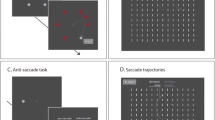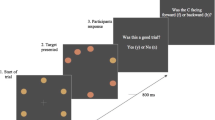Summary
A review of recent experimental and theoretical findings is presented which relates the results of neurophysiological and psychological research on attention and eye movement to cognitive theorizing. With respect to the relation between shifts of attention and saccadic eye movements, several experiments have demonstrated that it is possible to dissociate the line of attention from the gaze direction. On the other hand, there is some indirect (although not yet conclusive) evidence that saccadic eye movements always produce a concomitant shift of attention. Another question is whether there is a moment-to-moment control of each consecutive saccade and latency or whether indirect control models (i.e. planning several saccades in advance) are more appropriate. The function of attentional processes which have to coordinate stimulus driven (bottom-up) and concept driven (top-down) mechanisms are discussed and related to some studies investigating local and global scanpaths.
Similar content being viewed by others
References
Berlyne DE (1958) The influence of complexity and novelty in visual figures on orienting responses. J Exp Psychol 55:289–296
Bouma H, Voogd AH de (1974) On the control of eye saccades in reading. Vision Res 14:273–284
Breitmeyer BG, Ganz L (1976) Implications of sustained and transient channels for theories of visual pattern masking, saccadic suppression and information processing. Psychol Rev 83:1–36
Buswell GT (1935) How people look at pictures. University of Chicago Press, Chicago
Carpenter PA, Just MA (1983) What your eyes do while your mind is reading. In: Rayner K (ed) Eye movements in reading: perceptual and language processes. Academic Press, New York, pp 275–305
Duffy E (1962) Activation and behavior. Wiley, New York
Düker H (1956) Untersuchungen über die sogenannte Aufmerksamkeit. Bericht 20. Kongress der Deutschen Gesellschaft für Psychologie, Berlin 1955. Hogrefe, Göttingen
Egly R, Homa D (1984) Sensitization of the visual field. J Exp Psychol [Hum Percept] 10:778–793
Ellis SR, Smith JD (1985) Patterns of statistical dependency in visual scanning. In: Groner R, McConkie GW, Menz C (eds) Eye movement and human information processing. North Holland, Amsterdam, pp 219–238
Engel RL (1971) Visual conspicuity, directed attention and retinal locus. Vision Res 11:563–576
Eriksen CW, Hoffman J (1973) The extent of processing of noise elements during selective encoding from visual displays. Percept Psychophys 14:155–160
Eriksen WW, Murphy TD (1987) Movements of attentional focus across the visual field: a critical look at the evidence. Percept Psychophys 42:299–305
Fischer B (1987) The preparation of visual guided saccades. Rev Physiol Biochem Pharmacol 106:1–35
Fischer B, Boch R (1983) Saccadic eye movements after extremely short reaction times in the monkey. Brain Res 260:21–26
Fischer B, Breitmeyer B (1987) Mechanisms of visual attention revealed by saccadic eye movements. Neuropsychologia 25:73–83
Fischer B, Ramsperger E (1984) Human express-saccades: extremly short reaction times of goal directed eye movements. Exp Brain Res 57:191–195
Fisher DF, Shebilske WL (1985) There is more that meets the eye than the eyemind assumption. In: Groner R, McConkie GW, Menz C (eds) Eye movements and human information processing. North Holland, Amsterdam, pp 149–157
Goldberg MH, Wurtz RH (1972) Activity of superior colliculus in behaving monkey. II. Effect of attention on neuronal responses. J Neurophysiol 35:560–574
Gopher D (1973) Eye movement patterns in selective listening tasks of focussed attention. Percept Psychophys 14:259–264
Grindley DG, Townsend V (1968) Voluntary attention in peripheral vision and its effects on acuity and differential thresholds. Q J Exp Psychol 20:11–19
Groner R (1978) Hypothesen im Denkprozess. Grundlagen einer verallgemeinerten Theorie auf der Basis elementarer Informationsverarbeitung. Huber, Bern
Groner R, Groner M (1982) Towards a hypothetico-deductive theory of cognitive activity. In: Groner R, Fraisse P (eds) Cognition and eye movements. North Holland, Amsterdam, pp 100–122
Groner R, Groner M (1987) Hypothesis theory — a review. In: Meer E van der, Hoffmann J (eds) Knowledge aided information processing in human beings. North Holland, Amsterdam, pp 193–219
Groner R, Menz C (1985) The effects of stimulus characteristics, task requirements and individual differences on scanning patterns. In: Groner R, McConkie GW, Menz C (eds) Eye Movements and human information processing. North Holland, Amsterdam, pp 239–250
Groner R, Walder F, Groner M (1984) Looking at faces: Local and global aspects of scanpaths. In: Gale AG, Johnson F (eds) Theoretical and applied aspects of eye movement research. North Holland, Amsterdam, pp 523–533
Groner R, Groner M, Hofer D (1986) The role of anticipiation in the encoding of motion signals — sensitization or bias. In: Klix F, Hagendorf H (eds) Human memory and cognitive capabilities. Mechanism and performances. North Holland, Amsterdam, pp 275–285
Held R, Ingle D, Schneider GE, Trevarthen CB (1967) Locating and identifying: two modes of visual processing. Psychol Forsch 31:44–62, 299–348
Helmholtz H von (1909) Handbuch der physiologischen Optik, 3rd edn. Voss, Hamburg
Hinton JW (1982) Ocular responses to meaningful visual stimuli and their psychological significance. In: Groner R, Fraisse P (eds) Cognition and eye movements. North Holland, Amsterdam, pp 204–212
Johnston WA, Dark VJ (1986) Selective attention. Annu Rev Psychol 37:43–75
Jonides J (1981) Voluntary versus automatic control over the mind's eye's movement. In: Long J, Baddeley A (eds) Attention and performance IX. Laurence Erlbaum, Hillsdale, pp 187–203
Julesz B (1984) Toward an “axiomatic” theory of preattentive vision. In: Edelmann GM, Gall WE, Cowan WM (eds) Dynamic aspects of neocortical function. Wiley, New York
Just MA, Carpenter PA (1980) A theory of reading: from eye fixation to comprehension. Psychol Rev 87:329–354
Kahnemann F (1973) Attention and effort. Prentice-Hall, Englewood Cliffs
Klein F (1980) Does oculomotor readiness mediate cognitive control of visual attention? In: Nickerson R (ed) Attention and performance. VIII. Lawrence Erlbaum, Hillsdale, pp 259–276
Koga K, Groner R (1988) Intercultural experiments as a research tool in the study of cognitive skill acquisition: Japanese character recognition and eye movements in non-Japanese subjects. In: Mandl H, Levin J (eds) Knowledge acquisition from texts and pictures. North Holland, Amsterdam, pp 279–291
Lambert AJ (1987) Expecting different categories at different location and selective attention. Q J Exp Psychol 39A:61–76
Lévy-Schoen A, O'Regan JK (1979) The control of eye movements in reading. In: Kolers PA, Wrolstad ME, Bouma H (eds) Processing of visible language, vol 1. Plenum Press, New York, pp 7–36
Mackworth NH, Morandi A (1967) The gaze selects informative details within pictures. Percept Psychophys 2:547–552
Magoun HW (1963) The waking brain. Thomas, Springfield
Mayfrank L, Mobashery M, Kimmig H, Fischer B (1986) The role of fixation and visual attention on the occurence of express saccades in man. Eur Psychiatry Neurol Sci 235:269–275
Maylor EA (1985) Facilitatory and inhibitory components of orienting in visual space. In: Posner MI, Marin OSM (eds) Attention and performance. XI. Lawrence Erlbaum, Hillsdale
Mertens JJ (1956) Influence of knowledge of target location upon the probability of observation of peripherally observable test flashes. Opt Soc Am 46:1069–1070
Mowrer OH (1941) Preparatory set (expectancy). Further evidence of its central locus. J Exp Psychol 28:116–133
Müller HJ, Findlay JM (1987) Sensitivity and criterion effects in the spatial cueing of visual attention. Percept Psychophys 42:383–399
Navon D, Gopher D (1979) On the economy of the human processing system. Psychol Rev 86:114–255
Norman DA (1968) Towards a theory of memory and attention. Psychol Rev 75:522–536
Norman DA, Bobrow DG (1975) On data-limited and resource-limited processes. Cognitive Psychol 7:44–64
Noton D, Stark L (1971) Scanpaths in saccadic eye movements while viewing and recognizing patterns. Vis Res 11:929–942
O'Regan JK (1979) Eye guidance in reading: evidance for the linguistic control hypothesis. Percept Psychophys 25:501–509
O'Regan JK (1983) Elementary perceptual and eye movement control processes in reading. In: Rayner K (ed) Eye movements in reading: perceptual and language processes. Academic Press, New York, pp 121–139
Posner MI (1978) Chronometric explorations of mind. Lawrence Erlbaum, Hillsdale
Posner MI, Nissen MJ, Ogden WC (1978) Attended and unattended processing modes: the role of set for spatial location. In: Pick HL, Saltzman EJ (eds) Modes of perceiving and processing information. Lawrence Erlbaum, Hillsdale, pp 137–157
Posner MI, Snyder CRR, Davidson BJ (1980) Attention and the detection of signals. J Exp Psychol 109:160–174
Putz-Osterloh B, Lüer G (1979) Wann produzieren Probanden räumliche Vorstellungen beim Lösen von Raumvorstellungsaufgaben? Z Exp Angew Psychol 26:138–156
Rayner K (1977) Visual attention in reading: eye movements reflect cognitive processes. Memory Cognition 4:443–448
Rayner K, McConkie GW (1976) What guides a reader's eye movements? Vision Res 16:829–837
Remington RW (1980) Attention and saccadic eye movements. J Exp Psychol [Hum Percept] 6:726–744
Remington R, Pierce L (1984) Moving attention: evidence for time-invariant shifts of visual selective attention. Percept Psychophys 35:393–399
Ross E, Ross S (1985) Target information and eye movement latency. In: Groner R, McConkie GW, Menz C (eds) Eye movements and human information processing. North-Holland, Amsterdam New York Oxford, pp 41–57
Rovamo J, Virsu V (1979) An estimation and application of the human cortical magnification factor. Exp Brain Res 37:495–510
Saslow MG (1967) Effects of components of displacement-step stimuli upon latency of saccadic eye movement. J Opt Soc Am 57:1024–1031
Shebilske W (1975) Reading eye movements from an information processing point of view. IN: Massaro D (ed) Understanding language. Academic Press, New York
Shepherd M, Findlay JM, Hockey RJ (1986) The relationship between eye movements and spatial attention. Q J Exp Psychol 38A:475–491
Shiffrin RM, Gardner GT (1972) Visual processing capacity and attentional control. J Exp Psychol 93:72–82
Shiffrin RM, Schneider W (1977) Controlled and automatic human information processing. II. Perceptual learning, automatic attending — a general theory. Psychol Rev 84:127–190
Shulman GL, Remington RW, McLean JP (1979) Moving attention through visual space. J Exp Psychol [Hum Percept] 5:522–526
Spillmann L (1971) Foveal perceptive fields in the human visual system measured with simultaneous contrast in grids and bars. Pflügers Arch 326:281–299
Stark L, Ellis SR (1981) Scanpaths revisited: cognitive models direct active looking. In: Fisher DF, Monty RA, Senders JW (eds) Eye movements: cognition and visual perception. Lawrence Erlbaum, Hillsdale, pp 193–226
Treisman A, Gelade G (1980) A feature-integration theory of attention. Cognitive Psychol 12:97–136
Trevarthen CB (1968) Two mechanisms of vision in primates. Psychol Forsch 31:299–337
Tsal Y (1983) Movements of attention across the visual field. J Exp Psychol [Hum Percept] 9:523–530
Ungerleider LG, Mishkin M (1982) Two cortical visual systems. In: Ingle DJ, Goodale MA, Mansfield RJW (eds) Two cortical visual systems. MIT Press, Cambridge, Mass.
Vaughan J (1979) Control of visual fixation duration in search. In: Senders JW, Fisher DF, Monty RA (eds) Eye movements and the higher psychological functions. Lawrence Erlbaum, Hillsdale, pp 135–140
Vaughan J, Graefe TM (1977) Delay of stimulus presentation after the saccade in visual search. Percept Psychophys 22:201–205
Wickens CD (1984) Processing resources in attention. In: Parasuraman R, Davis EA (eds) Varieties of attention. Academic Press, Orlando, Florida, pp 63–102
Wurtz RH, Mohler CW (1976) Enhancement of visual responses in monkey striate cortex and frontal eye fields. J Neurophysiol 39:766–772
Yarbus AL (1967) Eye movements and vision. Plenum Press, New York
Zingale CH, Kowler E (1987) Planning sequences of saccades. Vision Res 27:1327–1341
Author information
Authors and Affiliations
Additional information
Supported by the Swiss National Science Foundation, grants 1.187.85 and 3.940.84
Rights and permissions
About this article
Cite this article
Groner, R., Groner, M.T. Attention and eye movement control: An overview. Eur Arch Psychiatr Neurol Sci 239, 9–16 (1989). https://doi.org/10.1007/BF01739737
Received:
Issue Date:
DOI: https://doi.org/10.1007/BF01739737




